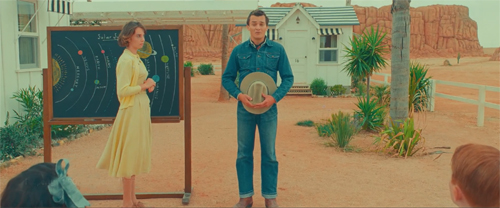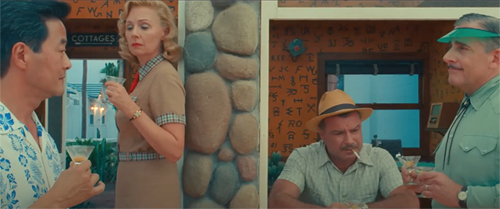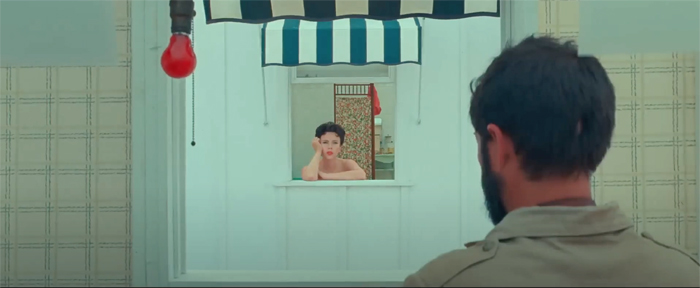Asteroid City (2023).
DB here:
Asteroid City tells two stories. One ends more or less happily, the other more or less sadly.
The first one takes place in roadside America, 1955. In a minuscule town made famous by an asteroid crater, five finalists for Junior Stargazer awards assemble with parents and siblings for the ceremony. They mingle with the locals, the scientists at the observatory, a batch of primary-school kids, a military unit, and an itinerant cowpoke band. The big day is interrupted by the arrival of an alien bent on retrieving the asteroid. This exceptionally polite invasion spurs all of the visitors to reconsider their life options. After a second visit from the alien, the travelers leave. Enlightened? A little bit.
This story is shot in anamorphic widescreen and color as glowing as Kodachrome. The second story, interwoven with the first one, is presented in 4:3 black and white. It presents episodes from a television program purporting to document the production of a typical American play. But the host, a generic, all-knowing announcer, tells us that the play “Asteroid City” does not exist, was never performed and has only an “apocryphal” existence, whatever that means.
But instead of the usual behind-the-scenes chronicle of putting on a show, we get only glimpses of preparation and performance, arranged out of chronological order. We hear alternative speeches and learn of scenes that will eventually be cut. The last stretch of the second story is a morose reflection on what the play might mean, with the director’s response to that question a simple: “Just keep telling the story.” As if in reply, the epilogue of the visitors’ Asteroid City adventure is the (rousing) conclusion of the whole movie we’re watching.
Like Marianne Moore’s “imaginary gardens with real toads in them,” Asteroid City (the town) is a fantasy world, but it’s not free of danger. There’s death. Atomic tests are conducted next door.
Within this carpentered world, all right-angled motel cottages and perpendicular lanes and train tracks, two forces are at work. There is Science, embodied in the astronomical research of Professor Hickenlooper and her fanciful accounts of cosmic activity. The Junior Stargazers have all come up with wild breakthroughs–a tethered jet pack, a way of projecting pictures on the moon–that prove that these teenagers are both brilliant and eccentric. From one angle the film, like Rushmore and The Life Aquatic, is a defense of visionary nerds.
Counterposed to Science is, not to put a fine point on it, Christianity. The kids brought to the ceremony by June recite prayers on command. Faith enters more poignantly with the Steenbeck family, headed by the photojournalist Augie. His wife has died, but not until they stop in Asteroid City does he break the news to his son Woodrow and three little daughters. It impels the girls to bury her cremated remains in a Tupperware bowl as they try out proper reverence. Is she in Heaven? Augie doesn’t believe in it, and Woodrow is uncertain, but it’s real for the girls, Augie says, because they’re Episcopalian.
Neither Science nor Christianity can account for the alien, or the strange indicia it has inscribed on the asteroid. The creature’s arrival comes at almost exactly the film’s midpoint, and thereafter hazy outlines of happy endings emerge. No spoilers, but here’s a hint: Love is involved.
All of which makes the film sound terribly abstract. It’s not. The clumsy online parodies of Anderson’s style make us forget how crisply economical it is. Forget movies padded out with cars pulling up or pulling away, close-ups of coffee being made, characters hunched over cellphones and workstations, roundy-roundy camera movements, and drone shots floating over a metropolis. Every shot here carries its fair weight.
Anderson’s geometric framing and staging demand a stream of small details. Moment by moment we have to take in gorgeous Populuxe furnishings, rapid dialogue, enigmatic signage, non sequiturs, abbreviated gestures and glances, and flickers of facial expression. For a few seconds a cigarette lighter is casually refilled with a squirt of gasoline (a good example of Brecht’s gestus, the piece of performance that crystallizes a social attitude: we’ll have oil forever). Soon enough a gizmo pulled from Augie’s decrepit engine thrashes on its own: Is this the alien? Just the range of cultural references dazzles. Anderson’s love of theatre emerges in recollections of plays from The Petrified Forest to Bus Stop, by way of Wilder and Williams. And are all the variants on a nonexistent play text his contribution to multiverse storytelling?
The embedded film has opened with a roaring freight train to a male voice singing “Last Train to San Fernando,” a song that celebrates a desperate chance for love. The whole film ends with a version of “Freight Train, Go So Fast” about a man being hanged, yet it’s sung by a mourning woman with sheer exhilaration. Asteroid City (the film) is poised between love and death, in the process celebrating the muted joy and welcome eccentricity of everyday life.
Not to mention hot dogs, chili, and strawberry milk.
Asteroid City has attracted many favorable Cannes reviews, but I’ve been disappointed in the dismissive comments offered by reviewers I respect. Many have taken the obvious line of objection (trademark whimsy, too many stars, too much artifice) without coming to grips with the distinctive qualities of the film. (But Bilge Eberi , Manohla Dargis, Richard Brody, and Glenn Kenny get it.) This seems to me one of Anderson’s very best works. It has a richness that my sketch here can’t capture, and I hope to write more about it later.
For more blog entries on Anderson’s films, go here.
PS 11 July: The streaming version of Asteroid City just released on Amazon Prime is of very poor photographic quality: low contrast and desaturated color. A version more faithful to the film is available on Apple +. I haven’t checked other sources.
Asteroid City (2023).
This entry was posted
on Saturday | May 27, 2023 at 5:49 pm and is filed under Directors: Anderson, Wes, Readers’ Favorite Entries.
Both comments and pings are currently closed.





